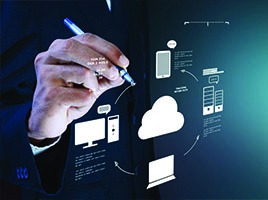Many enterprises these days employ both customer relationship management (CRM) and enterprise resource planning (ERP) in the drive to keep pace with the modern digital economy.
But while both of these software suites target different responsibilities in the business model, they are similar enough on an operational level that many organizations are using them in a highly collaborative manner, if not integrating them outright. Exactly how should this be carried out? And how should enterprise executives utilize these tools for the greater good of the business model?

What Is CRM?
CRM focuses primarily on the management and analysis of customer-oriented processes. An enterprise’s successful and fruitful relationships with its customers lie at the heart of furthering many enterprise goals, and rely on organized management of all interactions with customers and prospective customers. CRM software accomplishes these goals through management of customer and other business data, interaction channels and related business processes.
What Is ERP?
At its basic levels for every enterprise, ERP delves into back-office functions like billing and inventory. Strategically and more broadly, ERP gives the enterprise the ability to streamline the business model by coordinating resources and processes in ways that are not possible under previously segregated data ecosystems. ERP is the primary means of eliminating the data silos that hamper productivity and drive up costs in the enterprise.
What Are the Differences Between CRM and ERP?
CRM’s focus on the management and analysis of customer-oriented processes and ERP software’s focus on back-office functions like billing and inventory give rise to their overlapping responsibilities, since proper CRM often requires a smooth-running back-office process while sales and customer fulfillment are core objectives of any IT environment.
CRM can be used to spot new market opportunities and new sales leads, which will then trigger processes on the ERP side to order new or additional products, work out the logistics of getting them to the right location and track the purchase orders and other financial instruments to make it all happen. Naturally, the easier it is to hand one process off to another, the faster, and less costly, the entire project. So together, CRM can be used to maximize profit and ERP to minimize costs.
CRM and ERP System Integration
Not all processes are aimed at customers, however, so there is something to be said for not integrating CRM and ERP too closely. This is often reflected in the types of data that each solution tends to access. CRM incorporates a lot of unstructured data from customer interactions, email and social media, while ERP works with the structured data found in finance, product development and other departments. A key area for integration, then, is the data store containing both structured and unstructured data, as this will make it easier to eliminate duplicate data and conduct more accurate analysis of multiple data sets.
Still, many companies are finding that full integration of ERP and CRM is warranted for their particular business model. Even in these cases, however, the goal is usually not to create a single system that can do everything but to leverage the best tools on both platforms to support efficient and effective processes. Preserving these complementary strengths in CRM and ERP solutions leads to efficiency in both. This can be most pronounced in the time saved by sales and back-office teams that no longer need to be trained on two separate systems, or have to jump back and forth between them in order to implement a multi-faceted project. At the same time, all users now have full access to business tools, both in the office and on the road, which can prove invaluable during sales meetings and other events.
How to Decide Which Is Best for Your Situation
Determining where to apply the organization’s resources is guided by these integration outcomes. Other, less direct outcomes can tip the scale, as well. For some organizations and IT groups, a single platform is easier to maintain and troubleshoot, since it involves a single service contract from a single provider. Multivendor environments, of course, are notorious for their structural incompatibilities, which inevitably lead to multiple rounds of finger-pointing when trying to figure out why things are not working. And many organizations are finding that workflows proceed even more smoothly with a fully integrated platform – a function not just of the now-unified structure of the software itself but also the fact that it is working off a single, unified data environment.
The extent to which CRM and ERP should be integrated is a question best left to the enterprise, and top executives would be wise to involve the rank-and-file (aka, the people who actually use the software) to a high degree in the decision-making process. Both platforms are highly complex and require careful coordination among systems, data and people in order to deliver top results.
But the digital economy is evolving quickly, and the only sure way to get left behind is to believe that existing software and processes will continue to deliver into the future.
ERP Pricing: Get 2019 pricing on 45 different ERP systems. Click to download your free guide.







